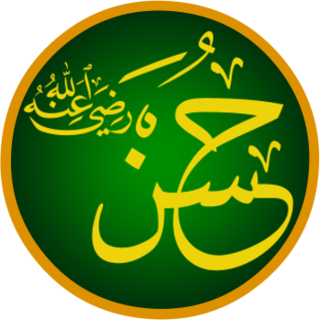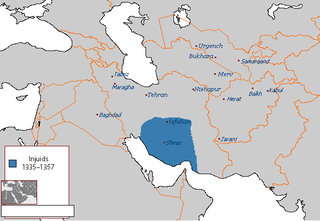
Al-Ḥasan ibn Alī ibn Abī Ṭālib, commonly known as Hasan or Hassan, was the eldest son of Ali and Muhammad's daughter Fatimah, and was the older brother of Husayn. Muslims respect him as a grandson of the Islamic Prophet Muhammad. Among Shia Muslims, Hasan is revered as the second Imam. Hasan was elected for the caliphate after his father's death, but abdicated after six or seven months to Muawiyah I, the founder of the Umayyad dynasty to end the First Fitna. Al-Hasan was known for donating to the poor, his kindness to the poor and bondmen, and for his knowledge, tolerance and bravery. For the rest of his life, Hasan lived in Medina, until he died at the age of 45 and was buried in the Jannat al-Baqi cemetery in Medina. His wife, Ja'da bint al-Ash'at, is commonly accused of having poisoned him.

Kufa is a city in Iraq, about 170 kilometres (110 mi) south of Baghdad, and 10 kilometres (6.2 mi) northeast of Najaf. It is located on the banks of the Euphrates River. The estimated population in 2003 was 110,000. Currently, Kufa and Najaf are joined into a single urban area that is mostly commonly known to the outside world as 'Najaf'.

The House of Inju was a Shia dynasty of Mongol origin that came to rule over the Persian cities of Shiraz and Isfahan during the 14th century AD. Its members became de facto independent rulers following the breakup of the Ilkhanate until their defeat in 1357.

Nuh II was amir of the Samanids (976–997). He was the son and successor of Mansur I.

Togha Temür, also known as Taghaytimur, was a claimant to the throne of the Ilkhanate in the mid-14th century. Of the many individuals who attempted to become Ilkhan after the death of Abu Sa'id, Togha Temür was the only one who hailed from eastern Iran, and was the last major candidate who was of the house of Genghis Khan. His base of power was Gurgan and western Khurasan. His name "Togoy Tomor" means "Bowl/Pot Iron" in the Mongolian language.

Muhammad of Ghazni was sultan of the Ghaznavid Empire briefly in 1030, and then later from 1040 to 1041. He ascended the throne upon the death of his father Mahmud in 1030. He was the younger of a set of twins; this circumstance resulted in civil strife. His reign lasted five months before he was overthrown by his twin Ma'sud I, after which he was blinded and imprisoned. Nine years later he was reinstated for a year before being slain by his nephew Maw'dud. According to Ferishta, his reign lasted only 50 days before he was blinded and imprisoned on the order of Ma'sud I. A year later he was murdered by his nephew Maw'dud.
Muhammad Aytimur was the leader of the Sarbadars of Sabzewar from 1343 until his death.
Yagi Basti was a member of the Chobanid family and the ruler of Shiraz for a part of 1343. He was the son of Amir Chupan by his second wife.
Kulū Isfandiyār was the leader of the Sarbadars of Sabzewar from 1346 until around 1347.
Shams al-Din was the leader of the Sarbadars of Sabzewar from 1347 until around 1348.
Khwaja Shams al-Din 'Ali was the leader of the Sarbadars of Sabzewar from 1348 until his death.
Zahir al-Din Karawi was the leader of the Sarbadars of Sabzewar from 1356 - 1359
Hasan II, also known as Fakhr al-Dawla Hasan, was the last ruler of the Bavand dynasty from 1334 to 1349. He was the brother, and successor of Sharaf al-Muluk.
Eskandar II, was the ruler of the Paduspanid dynasty from 1333 to 1359. He was the son and successor of Taj al-Dawla Ziyar.
Abū al-Ḥasan ʿUbayd Allāh ibn Yaḥyā ibn Khāqān was an Abbasid official who served twice as vizier, under caliphs al-Mutawakkil and al-Mu'tamid.







